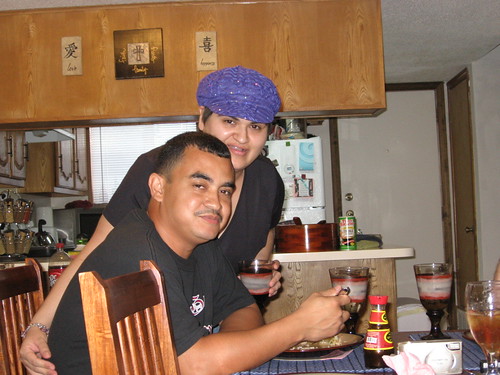It’s been a while since we’ve had one of our infamous dinner clubs at our house. I always had lots of fun having folks over for a themed meal — with everyone participating in the cooking and eating of the meal.
Granted, we do have our weekly small group which sometimes takes on the dinner club idea with everyone pitching in for the meal, but even participation in that’s been slacking as of late.
But I came across an interesting article today, talking about building community around the preparation and enjoyment of a family’s evening dinner.
When the Betz-Essinger family sits down for dinner in Birmingham, AL, it doesn’t take the children long to identify the provenance of their meal. “Is this a Caroline?†they ask, “or a Leigh Fran?â€
Caroline and Leigh Fran are not brands of frozen dinners—they are the two friends with whom Ruthann Betz-Essinger has shared the preparation of weeknight meals for more than a decade. Ruthann’s children “know how each of us cooks,†she laughs.
Through an arrangement known as “cooperative cooking,†the friends each prepare a single, large meal that will feed all three families, and package it up. One share goes into their own refrigerators, and on Sundays, the women meet at Betz-Essinger’s house to give each other the other two shares. So in exchange for cooking one meal, each family gets three meals—which, with leftovers, is often enough to provide dinner for every weeknight.
Everyone saves money in the end, because rather than buying ingredients for different meals, like a pound of ground beef and an onion for Monday night, a can of beans for Tuesday night, a piece of celery for Wednesday night, you can buy ingredients for one meal in bulk and hopefully build your meals around what’s on sale as well.
Or there are other options as well….
A potluck group may ask participants to contribute a component of the meal each time, and then eat together on a specific day of every week or month.
A meal group may rotate the preparation of a meal among the participants, and gather regularly at the host’s home to eat together.
The residents of the Eastern Village Cohousing community in Silver Spring, MD, do both. They begin the week with a standing Monday evening potluck, which anyone can join by bringing a dish to share. And they close out the weekend with a rotating Sunday meal group, in which each participant takes about two turns every three months to make dinner for 12 others.
As with Ruthann Betz-Essinger’s group, the members of a “pick-up†cooking co-op share cooking responsibilities but do the eating at home, with their own families.
In Bakersfield, CA, Jan Limiero organizes ten friends once a month to each prepare one recipe, for ten families, that will freeze well; each family takes home a freezer’s worth of different meals ready to reheat and serve. In Occidental, CA, six families stop by a member’s home from 6–7 p.m. on Mondays and Wednesdays to pick up a meal that one member has prepared for the others, according to the Sonoma County Independent. In Berkeley, CA, Laila Ibrahim is one of six adults in three neighboring households who have each rotated cooking, six nights a week, for more than seven years. The family that cooks delivers a meal to each of the others by 6 p.m.
All of these sound like great ways to build community and share expenses with friends and family — beyond just the normal potluck meals.
The article also shares a few pointers on getting a coop started:
Pick families who make it very easy to get the food to them, either through a common drop-off/pick up point, or by forming a co-op with neighbors or coworkers. Set up delivery times that fit with everyone’s schedule.
- Find people whose families are similar sizes, because it makes portioning easier.
- Find people with similar food tastes and practices.
- Establish clear guidelines for what the group expects each member to make when it’s his/her turn. A planning calendar can help to ensure a variety of foods.
- Find people who are prepared to accept and eat whatever is served, but are also willing to share honest feedback. “We might send a note with a meal we’ve made, saying, ‘This is hideous. I won’t ever make it again,’†laughs Betz-Essinger. “And sometimes I’ll get calls that say, ‘That wasn’t so bad.’ But sometimes they’ll call and say, ‘You’re right. Don’t ever make that again.’â€
- Package foods in containers that can be both frozen, reheated, and then reused, such as Pyrex baking dishes. Secondhand stores such as Goodwill can be an inexpensive way to acquire additional containers. If you’d like to eat well, save time and money, and build community in the process, consider forming a cooking co-op.
So what about you? Think you could do a cooking co-op? Have you tried anything like this before? Know of anyone stories from folks who have?

Sounds like a great idea!
yeah, i imagine this could save a lot of headaches and money.
yeah, i imagine this could save a lot of headaches and money.
Sounds like a great idea!
Sounds like a great idea!
yeah, i imagine this could save a lot of headaches and money.